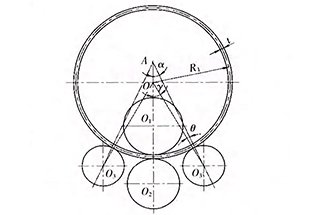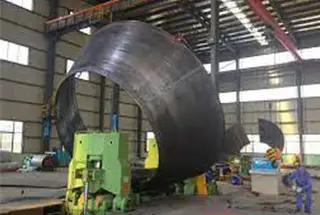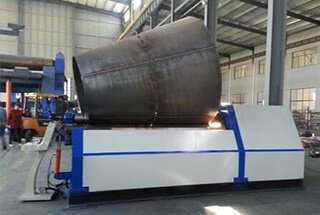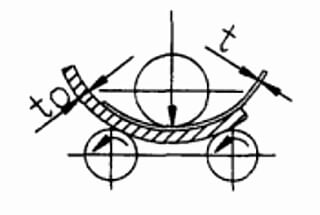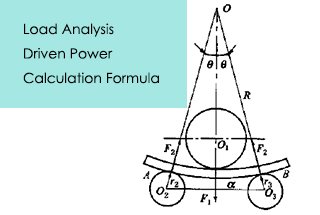
Ever wondered how massive metal sheets transform into precise cylindrical shapes? This article unveils the fascinating mechanics behind four-roll plate bending machines, exploring their structure, working principles, and the critical calculations for motor power selection. Get ready to dive into the engineering marvels that power industries like shipbuilding and petroleum!
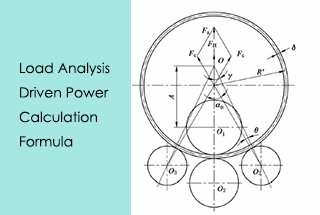
A plate rolling machine is a versatile forming equipment that transforms sheet metal into cylindrical, arc, and other complex shapes. This equipment plays a crucial role in various industries, including boiler manufacturing, shipbuilding, petroleum processing, chemical production, metal structure fabrication, and mechanical manufacturing.
The four-roll plate bending machine stands out for its superior performance characteristics. It offers convenient center alignment, minimal straight edge surplus, high accuracy in roundness correction, and exceptional efficiency. One of its key advantages is the ability to complete both pre-bending and workpiece forming in a single rolling process, eliminating the need for plate end switching. These features have solidified its position as an increasingly indispensable tool in sheet metal forming operations.
During operation, the four-roller plate bending machine experiences complex force conditions and significant loads, necessitating robust and rigid bearing components. The precision and reliability in designing the plate rolls are therefore paramount to ensure optimal performance and longevity of the equipment.
The design process begins with determining critical force parameters of the roll bending machine, including roller pressure, bending torque, and motor-driven power. A comprehensive load analysis of the rolling machine provides essential reference data for the precise design of the plate rolls, ensuring they can withstand the operational stresses.
Calculating the main driven power of the plate roll bending machine is a critical step in selecting the appropriate main motor. This calculation requires careful consideration, as motor selection impacts both performance and efficiency. An undersized motor will face prolonged overloading, leading to insulation damage due to excessive heat generation. Conversely, an oversized motor will operate inefficiently, wasting electrical energy and increasing operational costs.
Therefore, conducting a thorough load analysis and refining the driven power calculation for the four-roll plate bending machine has significant practical value. It enables engineers to select a motor that balances power requirements with energy efficiency, optimizing the machine’s performance and longevity.
This post aims to provide a comprehensive overview of the four-roll plate bending machine. We will delve into its basic structure and working principles, analyze its force capabilities in detail, and present the precise calculation formula for determining the main driven power. This information will serve as a valuable resource for engineers and technicians involved in the design, selection, and operation of these sophisticated metal forming machines.
The rolling machine operates based on the principle of three-point forming, utilizing the relative position change and rotational motion of the working roll to produce continuous elastoplastic bending and achieve the desired shape and precision of the workpiece.
The structure of the four-roller plate bending machine is shown in Figure 1 and is composed of several parts including a low frame, overturn device, upper roller, lower roller, two side rollers, high frame, connecting beam, base, balancing device, transmission device, electrical system, and hydraulic system.
The working roll of the four-roller plate machine consists of four rolls: an upper roll, lower roll, and two side rolls.
The upper roll is the main drive roll and is embedded in the high and low frame through a bearing body. Its position is fixed, allowing only for rotational motion.
The lower roll is fixed in a bearing pedestal, which can move in a straight line to compensate for the thickness of the bent plate.
The two side rollers are also installed in bearing pedestals, which can move up and down at a certain angle with the vertical direction to achieve the desired radius of cylinder curvature.
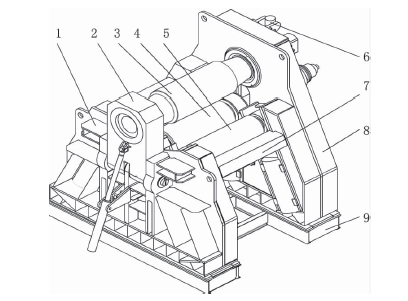
Fig.1 Structure of four-roll plate bending machine
In general, rolling a metal sheet into a cylindrical workpiece on a four-roll bending machine consists of four processes, namely:
During the operation of the rolling machine, the front end of the plate is placed between the upper and lower rollers and aligned with one of the side rollers. The lower roller is then raised to tightly press the plate, and the other side roller is lifted to apply force and bend the end of the metal plate.
For pre-bending the other end of the plate, it does not need to be removed from the rolling machine. Simply move the plate to the other end of the machine and repeat the process.
Continuous rolling is achieved through one-time or multiple-time feeding until the desired cylinder curvature radius is reached.
Finally, roundness corrections are performed to achieve the required roundness and cylindricity.
It can be seen that using the four-roll plate bending machine allows for the plate to be placed into the machine only once, achieving all the required bending.
As shown in FIG. 2, the stress distribution of the plate section along the direction of steel plate height during the linear pure plastic bending is shown in FIG. 2.
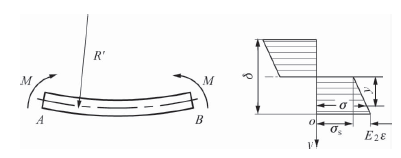
The functional relation of true stress can be expressed as follows:
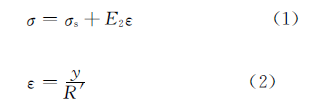
In the above formula:

In the above formula:
The bending moment on the cross-section M is:

Put formula (1)and(2)into(4), we get:

In the above formula:b– The maximum width of rolled sheet steel plate.
Initial deformation bending moment M0 is:

The structural characteristics of the four rolls allow for two different arrangements: a symmetrical arrangement and an asymmetrical arrangement.
Therefore, a separate force analysis of the four-roll machine is necessary.
2.2.1 The rollers are arranged in a symmetrical manner
The force of the steel plate is shown in FIG. 3.
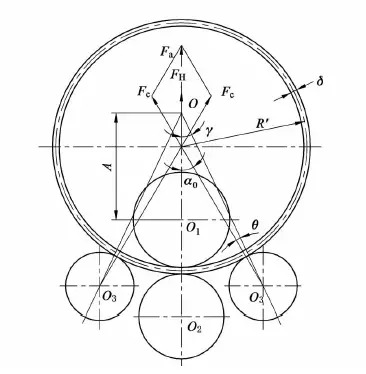
According to the force balance, the force of each working roll on the steel plate can be obtained:

In the above formula:
The value of α0 can be determined by the following formula according to the geometric relationship:
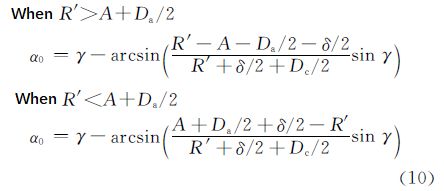
In the above formula:
2.2.2 The rollers are arranged in an asymmetrical manner
The force of the steel plate is shown in FIG. 4 when the roller is arranged asymmetrically.
According to the force balance, the force of each working roll on the steel plate can be obtained:
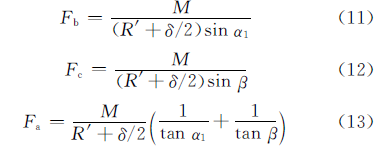
In the above formula:
The value of α, β can be determined by the following formula according to the geometric relationship:

In the above formula:

In the formula: A1 = Asinγ/sin(γ – φ)

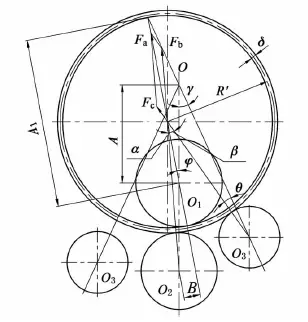
The upper roller of the four-roll bending machine is a driven roller, and the total drive torque acting on it is the sum of the torque consumed by deformation and friction.
The friction torque includes the friction resistance consumed in rolling the shaft roller on the bending plate and the torque consumed by bearing friction.
The torque consumed in deformation can be determined by the work done by the internal bending force and the external force on the upper roller.

In the formula:
Make formula (17) equal to formula (18), we get the torque consumed in deforming:

The torque for overcoming friction can be determined by formulas (19) and (20).
Friction torque of shaft roller in the symmetrical arrangement:

Friction torque of shaft roller in the asymmetrical arrangement:

In the above formula:
The total driving torque on the upper roller is:

The calculation formula for driving power is:

In the formula:
According to the actual application condition of the four-roll plate bending machine, the driving power of the driving roller is calculated during the pre-bending and rolling process, and the driving power of the main drive system is the larger value in the calculation result:

In the above formula:
The calculated value Pq of the driving power can be used as the basis for selecting the main motor power.
(1) Based on the structural characteristics and working principle of the four-roll plate bending machine, the force of the working roller is analyzed and the formula for calculating the working roll under different arrangements is obtained.
(2) By analyzing the maximum deformation bending moment and bearing force of the working roller, and using function transformation principles, the relationship between force, bending moment, and device driving power is established. A method to calculate the driving power of the main drive system is proposed.
According to actual application conditions, the driving power for pre-bending and rolling is calculated separately, and the main motor power is selected based on the larger calculated value.

